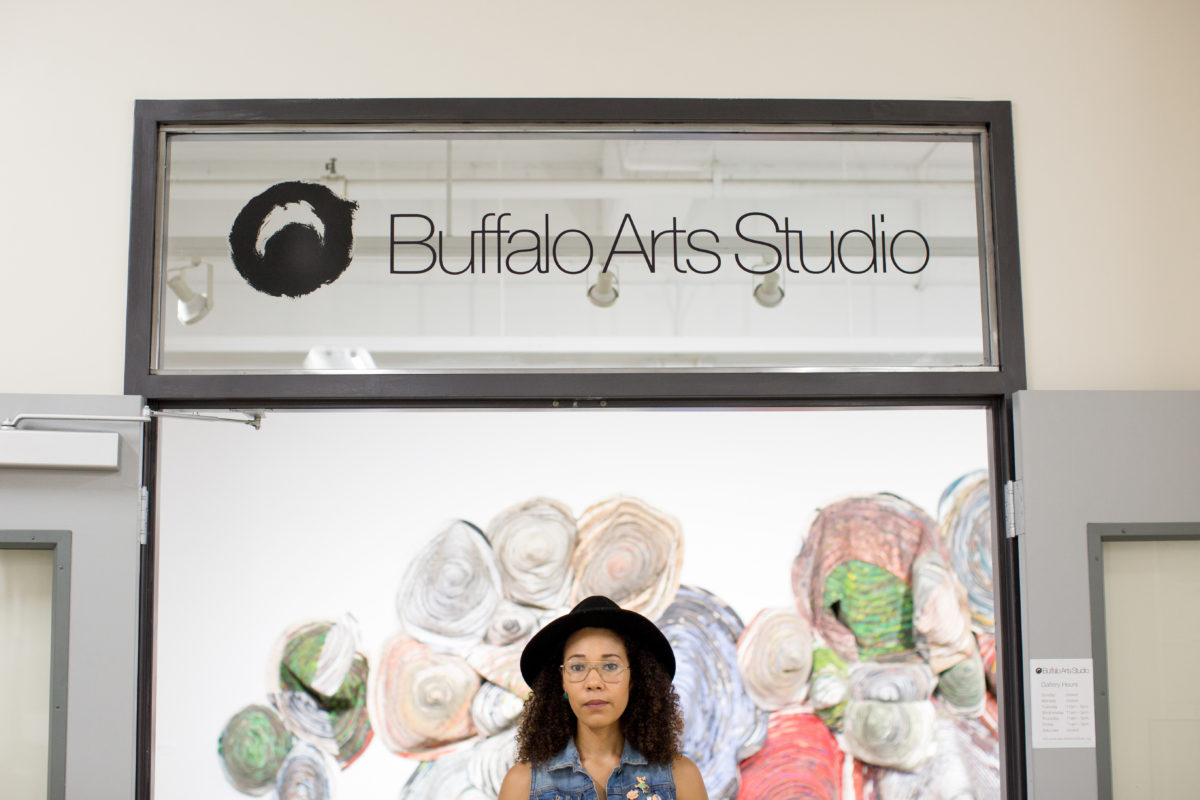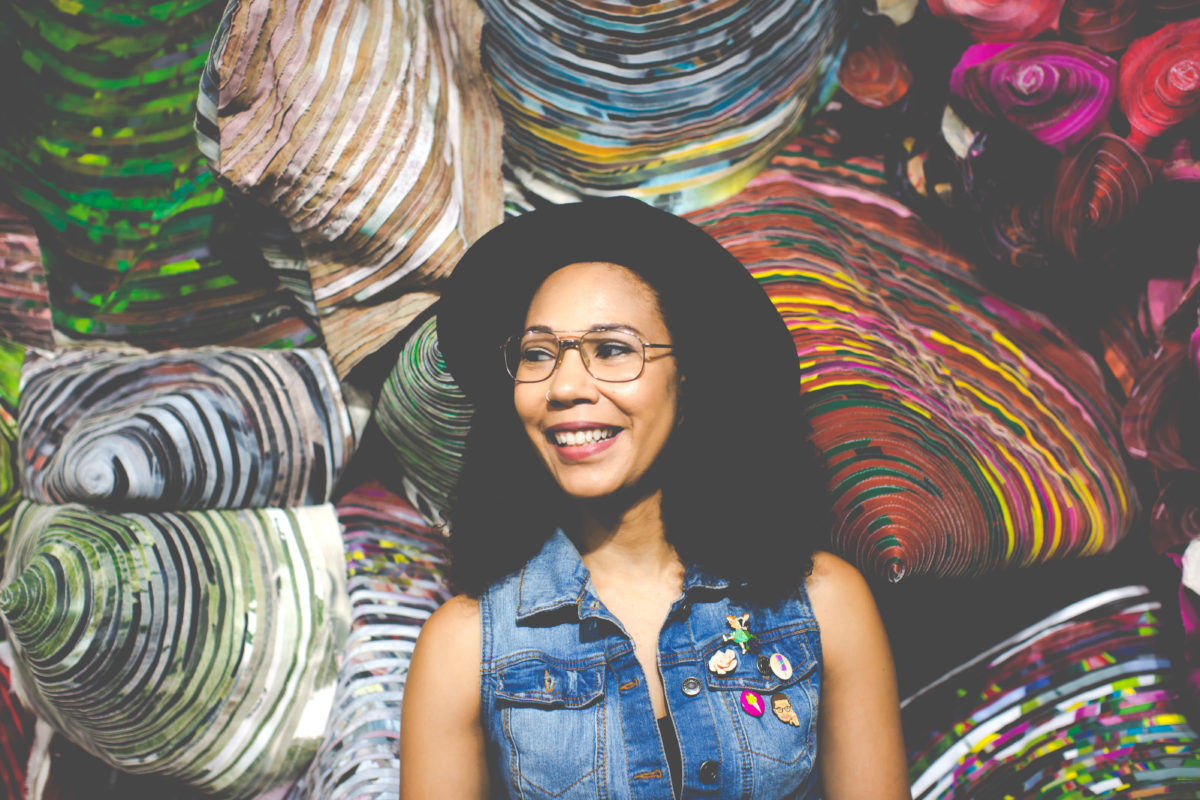
If you don’t know local artist Julia Bottoms-Douglas, you will soon.
The 29-year-old has ascended in the local art community from gracing the cover of The Public to being named Open Buffalo’s first Emerging Artist to nabbing one of the four artist spots to paint the Albright-Knox Public Art installation, The Freedom Wall.
Before this rise, it took Julia a bit to find her way at Buffalo State College, switching from Design to Education and continuing on to finish an M.A. in Multidisciplinary Studies. The first switch, she explains, was prompted by the realization that the program she was enrolled in was competitive and ill-suited for her desire to solely do illustrations. For her, it has always come back to art. She was lucky enough to have parents that were supportive of her aspirations from a young age.
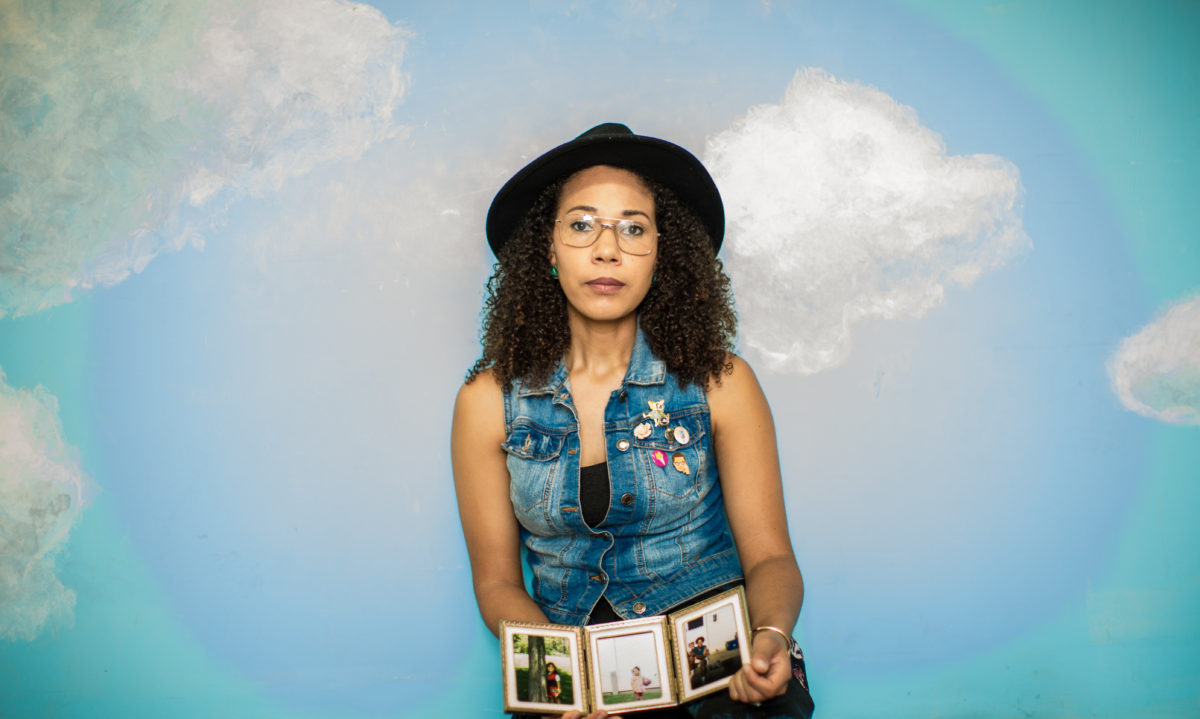
But the root of her inspiration for her current work lies within the people she meets daily. “Each of those people bring out a little inspiration in me,” she said. She also credits her husband and creative partner, the musician Elliott Douglas. “He’s my muse to some extent.”
What is it I’m upset about it? And, how can I translate it into my work?
Her creative process is a combination of intuition, personal practice, and drive. “I think you can learn to be a good artist technically, if you don’t have as much creativity but if you do have that drive toward personal practice then you can definitely learn to be a technically gifted artist. But, I think the creativity is having that passion for it and that creativity is what’s going to make you want to put in all those hours.”
In the studio, she paints to D’Angelo and Maxwell, or any neo-soul, spending anywhere from two sittings to several months completing pieces, putting those hours in. The pieces are acrylic and oil in equal parts and she is drawn to portraiture as it gives her the ability to “tell a story without necessarily using words.” Her process begins with the questions, “What is it I’m upset about it? And, how can I translate it into my work?” With the series featured in her first exhibit she answered those questions: “Rather than representing what I’m upset about, I’m representing how I want it to be, which is portraying [people of color] in a positive light.”
At the beginning of June, Julia closed her first show at Buffalo Arts Studio, “Tinted: A Visual Statement on Color, Identity, and Representation,” a series that challenges the representations of Black people, especially Black men, by expressing the identities and characteristics that society and the media typically denies them. It is not that Black people do not exist within the roles and boxes that society affords them, but what is beyond the boxes?, she asks.
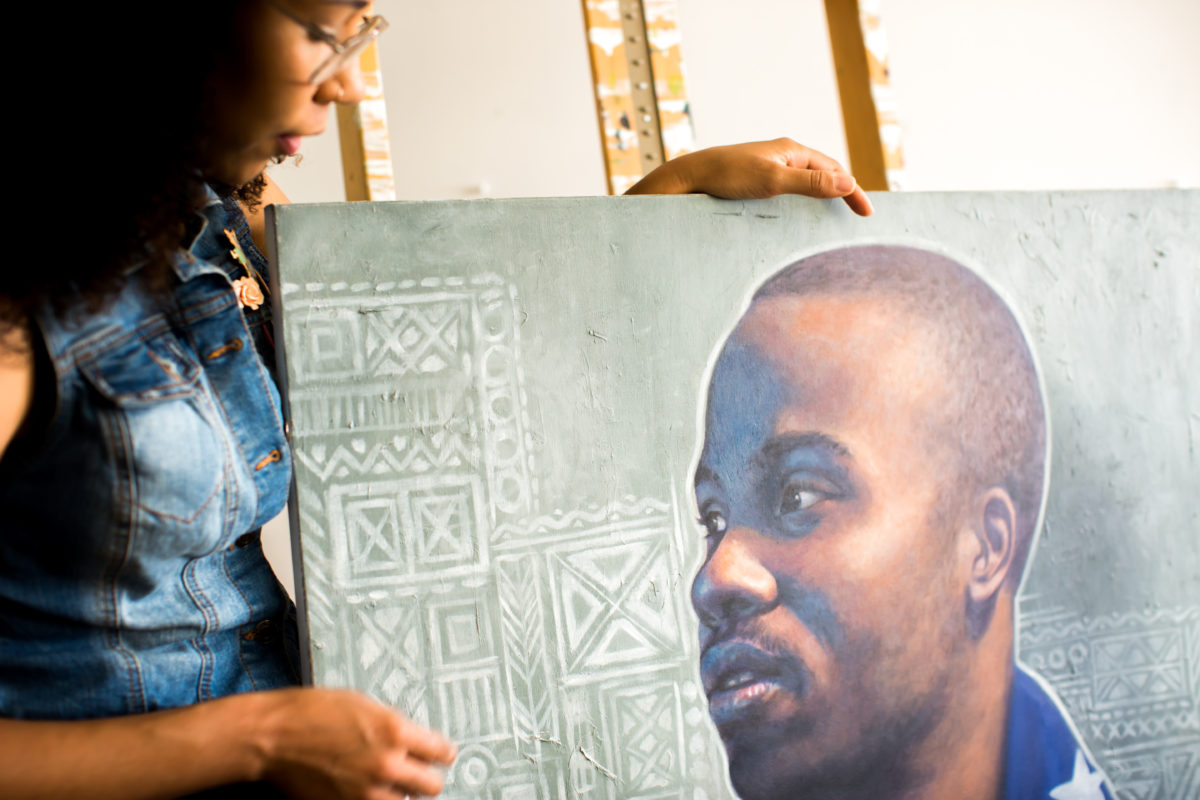
Julia cites the Trayvon Martin case when reflecting on her process for this particular series. “For me, it was a big turning point, not necessarily because of what happened but because it showed me my own lack of understanding. When I heard the story, I didn’t think it was real. I thought it was some sort of hoax. I just couldn’t believe that this sort of thing could happen in my time period.”
Yet, Julia has experienced several corners of WNY, and, as a child of mixed heritage — maternally Black and paternally Greek — she was well-prepared for racism. She recalls walking home as a child from Maryvale High School with her sister, when a white adult male approached them, told them to go back to Africa, and finished his verbal assault with the n-word acting as a form of punctuation. “I was a kid. I didn’t know how to react. We were stunned. And, he kept walking.”
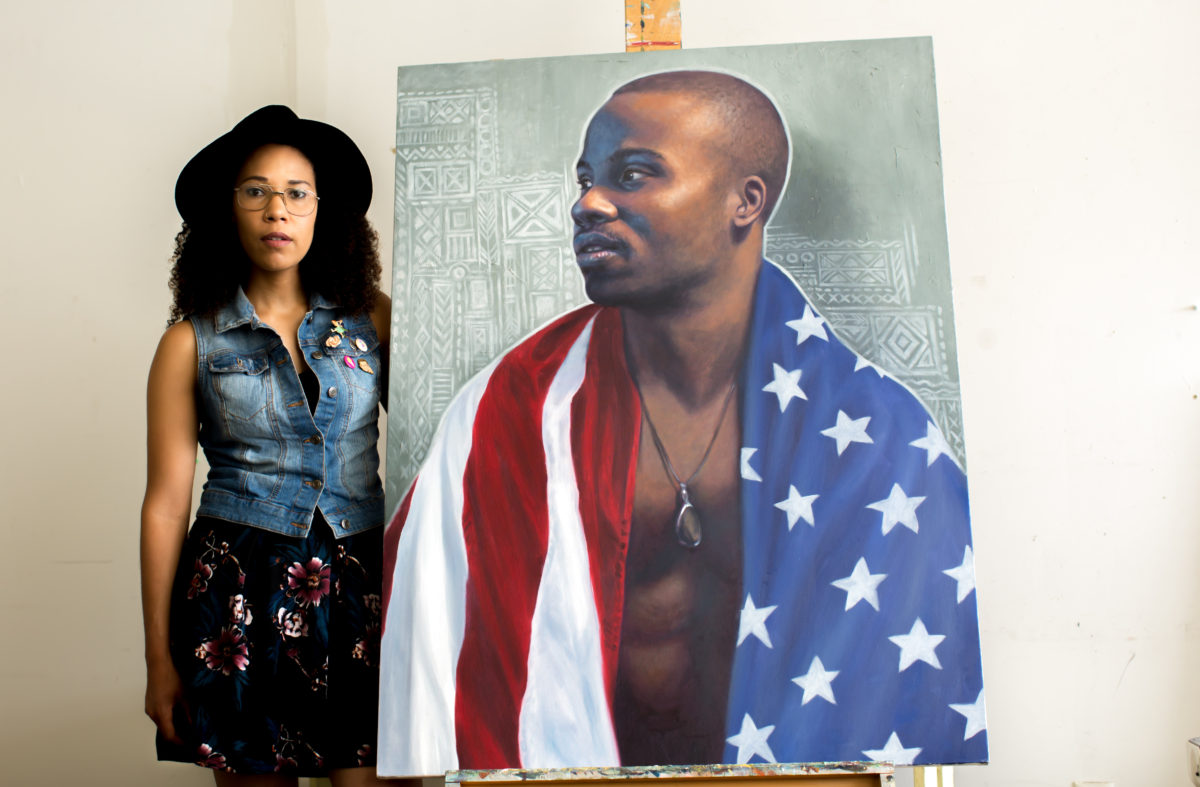
Even with this experience, and many more, Julia says, “I’ve known since I was kid that we live in a culture of racism. But, I genuinely didn’t know that people were still being murdered.”
This insistence that she and her sister leave this country denied them of their identities. “I should go back? My people helped build this country into what it was. America would cease to exist as it is. To fail to recognize that we had a significant essential contribution to the foundation of this country then, in a way, we’re stripped of our pride of being American…We don’t get to be in the middle ground. To say, I’m proud to be American, but I’m also proud to be African and my history isn’t separate from the history of this country.”
This sentiment is best expressed through her portrait Rook, in which a Black male looks to the right with an American flag draped cape-like around him. This is one of the most intentional uses of an object, as are the repetitious use of floral coronals on her male subjects as seen for example in Richie. “Flowers aren’t sexual. Why do we impose these things on men, just like we do on women? They are just neutral items.” The audience is forced to face their socialized interpretations of both Black men and flowers. The immediate urge is to feel a juxtaposition amongst the forced traits of masculinity and vulnerability as in, “Oh, he’s strong AND soft.” But, the point is not that this juxtaposition exists in Rook but that these men exist in the real world, embody several characteristics simultaneously, and that there is no juxtaposition. The contrast does not exist in reality, only within the representations we are all saturated in.
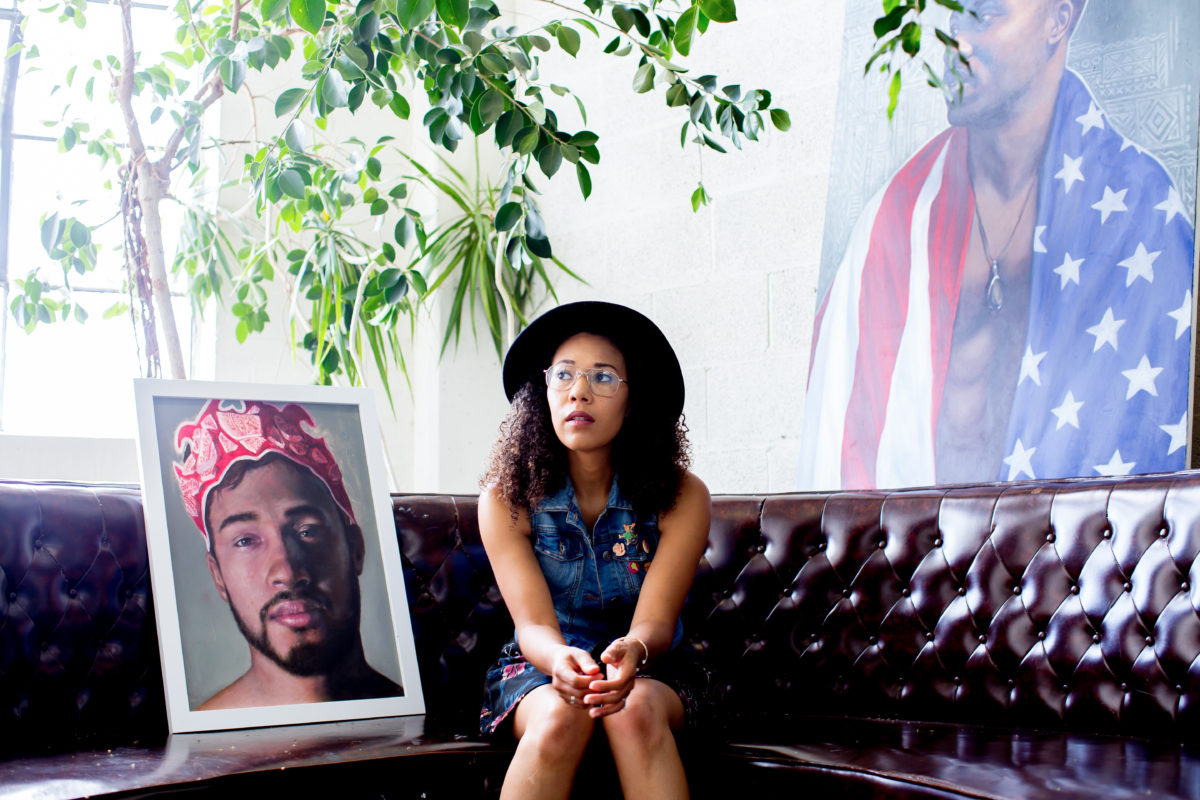
Her favorite piece in the series is Philmore, a subject she was first drawn to because of his skin and also, “There was something about him that was real quiet but at the same time sincere and real beautiful.” Philmore sits in front of an ethereally blue background with inscriptions scrawled behind him. Though Philmore displays all of the external qualities that first connected Julia to him, he also highlights her original inspiration, Trayvon Martin. The innocence and vulnerability they both imbue is undeniable.
Julia is an advocate battling these misrepresentations of Black men because, “I think at the back of our minds we know, if we don’t advocate for ourselves, who’s going to advocate for us?,” but as a Black woman she is on the frontline, facing off misrepresentations and experiencing it firsthand. “I’m fortunate enough that I’ve had more options given to me and I can recognize that. That’s a privilege in a sense. But, I think being born in that particular box, you don’t have many things.
“You get the idea that you can grow up, you can have kids, you can fit that female gender stereotype and then being a woman of color there’s that whole other set of stereotypes…The main thing I’ve had to face in my adult womanhood is being exoticized. My boss said something to the effect of commenting on my natural hair as sexy and wild…This is just what my hair does. This is my natural hair. I’m not doing anything to make it ‘wild and sexy.’ And, it’s not wild. It’s just my hair.”

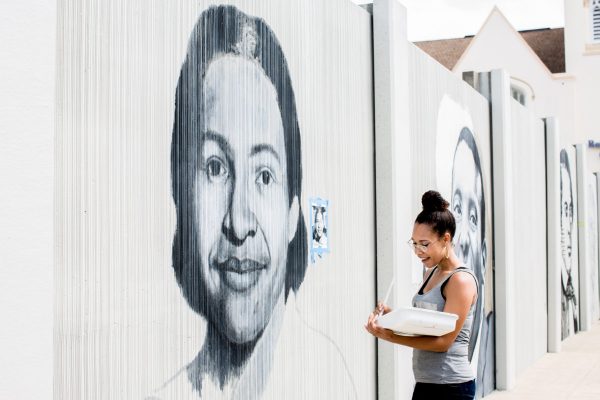
Photographer Alana A. Fajemisin captured the beginning stages of the Freedom Wall in July 2017. Click to see the full slideshow.
For Julia, it is this kind of act of existing and perseverance that can battle the racism she has always known. The course where she ran track in high school was sandwiched between the back of Maryvale High and a row of neighborhood homes. One of the houses waved a confederate flag, and she’d pass it at each practice during each lap.
And now, not much has changed, as racism persists and Julia runs circles around it.
You can go here to see more of Julia’s work and sign up to take part in a Buffalo Brush “paint night” class with her.
AlanAdetolArts, L.L.C. – Birdcage Studios – Buffalo, N.Y. 14213 –[email protected]
© 2018 AlanAdetolArts Photography LLC. All Rights Reserved. All images on these pages are copyrighted. Use or reproduction without prior written permission is prohibited.
Julia on the Buffalo Arts Studio
The catalyst for my entire involvement with anything to-date, including my solo show, my involvement on this mural, and much of my media coverage really stemmed from a panel discussion about 2 years ago at Buffalo Arts Studio. They hosted a discussion on Arts and Accessibility, specifically to the neighboring community around the gallery. I was invited to speak on the panel and give my thoughts on the barriers that often deter a more diverse gallery demographic.
After that panel discussion I stayed connected with BAS and Alma Carrillo, Executive Director, and Shirley Tokash Verrico, curator. Fast forward to last year, Shirley offered me the opportunity to hold my solo show at the gallery. I was nervous because this was my first experience working with a non-DIY space, and it was only my second solo show ever. This was a big jump for me and I needed a lot of professional development and assistance but the BAS team was 100 percent committed to helping me transition from an “emerging artist” to a local professional.
They walked me through questions on developing my image, personal promotion, networking, and even art pricing. BAS approached Open Buffalo with my work and asked them to collaborate on an annual sponsorship for an emerging artist, which they agreed to and generously donated a pretty big stipend towards my show. Open Buffalo does a lot of important community development and they felt my vision represented their goals for collaboration. They will now continue to support local artists every year through the gallery from this point on. So, needless to say, I was excited to be the first of what I hope is many more artists to come. Max Anderson worked very closely with me on the development of that collaboration and was incredibly supportive as well.
People from both of these organizations brought my name into the mural conversation when they began searching for additional artists.
I say all this because, looking back, all of this was very much a community effort and we can’t really talk about any success on my part without recognizing all of the people and organizations that offered me opportunities and committed themselves to assisting me along the way.
Thanks go to Buffalo Arts Studio, Open Buffalo, and even individual people like Lorna Hill (who mentioned me to Aaron Ott) and Bruce Adams, who suggested me for a panel speaker at the very first discussion.
